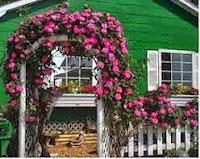 |
| photo by morguefile |
 |
|
Photo by: Johnston
The Gardeners Dirt ncsu-edu
|
Grow climbing roses on a garden arbor in a viewing area. The roses vine will add curb appeal of your home.
When to plant
climbing roses
The best time to plant is in early spring. Plant a bare root climbing rose bush as soon
as the soil is warm enough that you can dig up the soil. It is best to plant directly after the
threat of spring frost has past.
Where to plant roses
Roses need sun to grow so choose a garden site that has a
minimum of six hours of direct dun. The
soil needs to be well drained and fertile.
If your soil is poor or medium amend the soil with compost or
manure.
Climbing roses put out trailing stems that can grow upward or they can grow across and be used as a ground cover. Trailing rose stems with a profusion of flowers looks lovely when grown down a sunny slope.
Climbing roses put out trailing stems that can grow upward or they can grow across and be used as a ground cover. Trailing rose stems with a profusion of flowers looks lovely when grown down a sunny slope.
How to plant bare
root roses
Soak the bare root rose bush over night in a bucket of
water. Fill the bucket so the root of
the bush is emerged. Loosen the soil
with a shovel and work the soil so that the texture is fine and lofty. Amend the soil with organic matter; compost
or manure will enrich the soil.
Plant the rose bush so that the bud union is half buried in the soil. If you are planting more than one climbing rose bush then allow a three food space between rose bushes. Plant the climbing roses in front of a support.
Plant the rose bush so that the bud union is half buried in the soil. If you are planting more than one climbing rose bush then allow a three food space between rose bushes. Plant the climbing roses in front of a support.
Care for Roses
- Water well after planting the rose bushes and then monitor the soil so that the soil stays evenly moist during the growing season. If the soil should dry out then this will cause the roses to wilt and to have stress. Plan to water the climbing roses deeply once a week; 1 inch of water is better than watering them lightly throughout the week. The inch of water will get to the roots and will keep the rose bushes hydrated.
- If your summers are very hot then you will need to water the rose bushes more frequently. Test the soil with your finger. Stick your index finger into the upper soil and if the soil is dry at two to three inches then water the rose bushes.
- Apply three inches organic mulch; shredded leaves, pine needles, grass clippings or chipped wood around the rose bush but do not set the mulch on the stems of the rose bush. The mulch is to help retain moisture and to deter weed growth.
- Fertilize when the leaf buds appear. A time released fertilizer is preferred for growing climbing roses.
- Prune climbing roses in the spring to remove dead or damaged branches. Otherwise let your rose bush mature and become established in your garden. A climbing rose bush is considered mature in two years.
Learn more about pruning a climbing rose bush by viewing this YouTube video:

